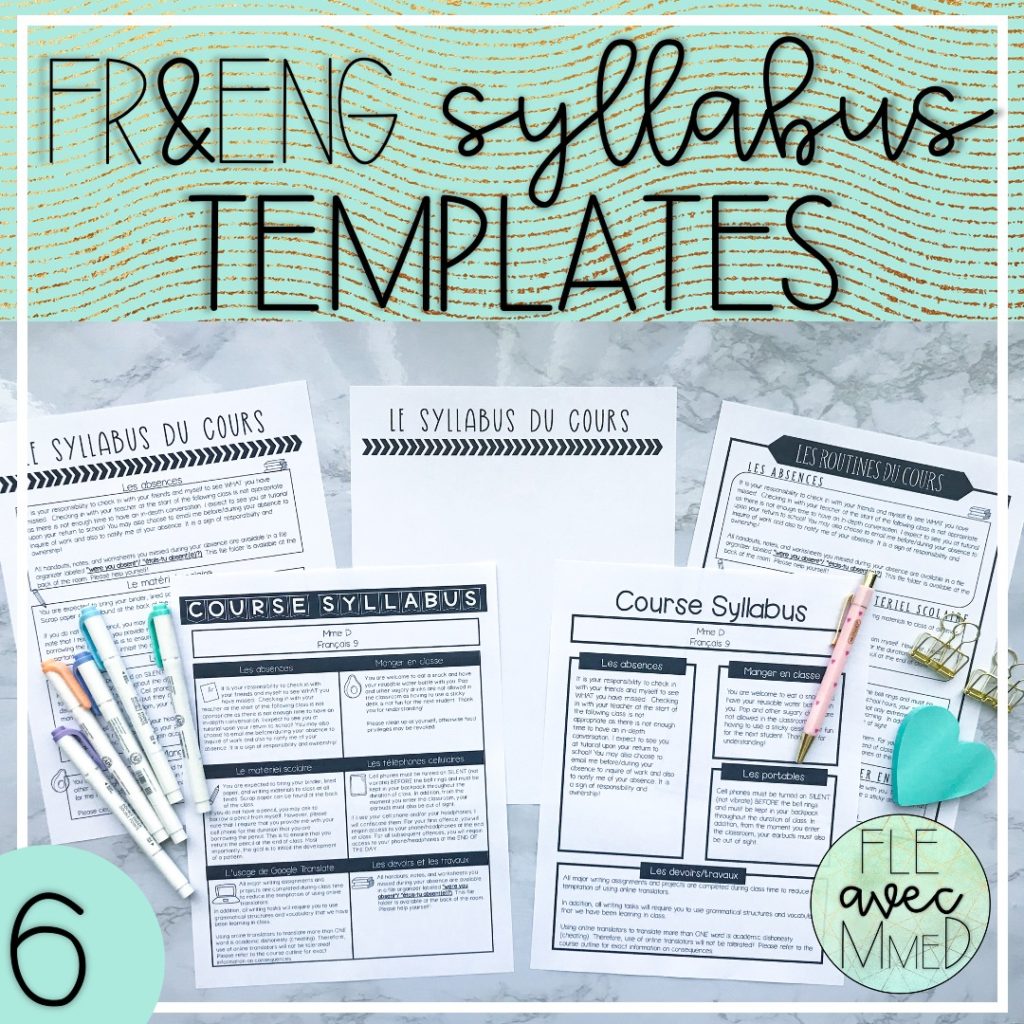
As a High School French teacher, teaching routines is one of the most important things that you can do to set your classes up for a great school year. Students need structure and routine, and the sooner you make your own routines & procedures clear and explicit, this will reduce students’ anxiety. This is especially true in French class! Today I am sharing mistakes to avoid in the first week of French class.
1. Not explaining our classroom routines thoroughly
To be completely honest, I didn’t even know my own classroom routines. I had tried to come up with a few routines, but because I was learning so much daily, my routines were often tweaked.
However, even the routines I knew I wanted to have, I still didn’t explain them well enough at the beginning of the year.
Why didn’t I explain how the chairs need to be put up? This leads us to the next point and that is …
2. I thought that they would know basic things like how to exit a building during a fire drill.

This was by far the biggest mistake I made in my first and second years of teaching.
I assumed that my students would just know how to do certain things because they had been on this Earth for 13-15 years.
I was so wrong! That whole second year was a complete disaster and I learned so much from it. Everything from fire drills to assemblies, to projects and presentations, to handing things in.
The other mistake I made was that I explained something briefly for like 30 seconds and I never reminded them.
For example, I explained once how to hand assignments in. However, in reality, they probably needed to be reminded for the entire month of September before things would sink in.
3. Not re-teaching and going over procedures when they weren’t following them
Another HUGE mistake I made in my first two years was that I never took the time to re-explain procedures if students were not following them.
This is such a basic idea but somehow I completely missed it. If a few students left the classroom without putting up their chairs, I would just dismiss it. I would put up the chairs myself.
This created a pattern where certain students were repetitively not following procedures because I was not reinforcing them!
I knew I could not allow this to reoccur for the third year

The summer after my second year, I decided to create a document where I specified EVERY SINGLE ROUTINE in my classroom. From the moment they entered to the moment they left the classroom, everything was on this piece of paper.
Whether you are a new teacher or one with more experience, consider creating a classroom procedures document with every single routine explained in the document.
Here is what I changed the following year
1. I assumed they knew nothing
In September, I showed them how to put up chairs, how to toss their trash out, etc. We practiced EVERYTHING. Every time students did not follow procedures, I re-explained and re-demonstrated what I needed them to do.
They had a little laugh at me showing them how to stack their chairs but most importantly, they needed to understand that I had specific expectations of them!
2. Explain EVERY SINGLE procedure in extreme detail in writing AND orally
For example, if you are teaching students how to hand in assignments, start from the very beginning. What kind of paper? Where should they write their name? When do they hand in their assignment (beginning, middle or end of class)? Walk them through the procedure by modelling it!
Do this with every single procedure! Trust me — you will thank me later! This will save you SO much time later.
3. Have them do a written or physical scavenger hunt
Your students should practice procedures before the school year begins for real. I create a worksheet “scavenger hunt” with multiple-choice, true/false, and short answer questions. I also have them complete this scavenger hunt with their parents for homework. And this brings us to the next point…
4. Have their parents read & sign the procedures so that they can support you and their child
Building a great rapport with your students’ parents can be one of your biggest assets.
If they know what your classroom procedures are from the very beginning, this will help reduce the emails you receive. Plus, they can also answer their child’s questions or direct them to you.
I have my students’ parents sign the scavenger hunt in order to indicate that they have read and understood our classroom routines and procedures.
Here are some questions to answer in your classroom procedures document
1. What does the seating arrangement look like? Do students choose or do you?
2. What does the seating arrangement look like? Do students choose or do you?
3. What is your cellphone/listening device policy?
4. What are your start of class routines? Daily slides? A bell ringer?
5. Where do students find handouts if they were absent the previous class or if they lost their copy?
6. What online learning platforms will you be using? (tip : include QR codes to websites you’ll be using).
7. How and where do they hand in assessment?
8. What is your late work policy?
9. What do students need to know about absences? Do they email you? Is there a school-wide form they need to bring in?
10. What procedures do students follow after an absence?
11. What is your classroom (or school policy) for bathroom & water trips?
12. Can students eat in the classroom?
13. What needs to happen during drills and emergencies?
14. What is your classroom/department policy for Academic Dishonesty and the use of online translators?
15. What do students need to know for when you are absent?
16. What are your end of class routines and procedures?
I hope that these questions and tips were helpful for you setting up your own classroom routines and procedures. If you have any tips, suggestions or ideas not mentioned in this article, please share them below in the comments!
Avec plaisir,
Pav




